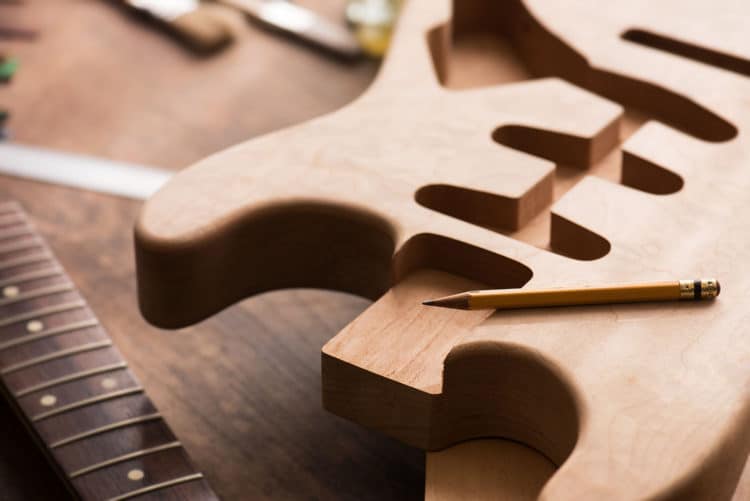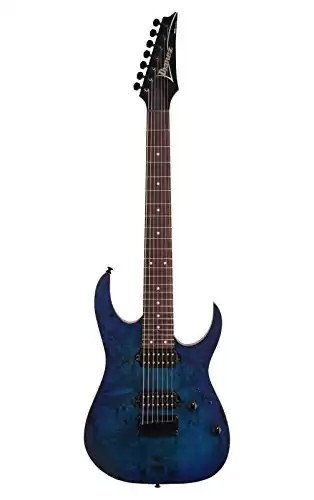Thick guitars tend to be quite heavy. They can often weigh more than ten pounds.
Thin guitars can also be heavy when built with mahogany or other dense woods, but they can also weigh about half as much.
Each design option impacts your sound. The notes you want to produce are what drive the decision on guitar body thickness as a musician.
How Guitar Body Thickness and Depth Affect Sound
A guitar’s shape and size impact note tone and sustain. If the inside of the instrument is larger, the sounds produced will have more of a booming component to them. Thicker and deeper designs typically sound more authoritative, while thinner models often have extra attack and crispness.
We know a guitar’s strings are responsible for the instrument’s notes. What often gets ignored or forgotten is each design’s physical qualities in how the sound gets shaped for the listener.
Although acoustic and electric guitars generate notes differently, the results are still the same when examining guitar body thickness.
The type of wood, the shape, and even where cavity or soundhole placement occurs provide variables that let musicians create different notes and chords.
When the strings get plucked or strummed, the vibrations move down each one to the guitar body’s interior. That causes the sound board to vibrate or send signals through the cords to the amplifier.
As the vibrations bounce inside the body and escape, their increased shape makes the sound louder as they reach the listener’s ears.
When a guitar body is larger, it will fill the room with more prominent sounds than something thinner. You’ll also get more loudness with a wider design, especially if you have an acoustic instrument.
How Thick Does a Guitar Top Need to Be?
The top thickness targets for modern guitars depend on the wood type used in the instrument’s construction. Spruce works well when the top thickness target is approximately 2.5 mm. Softer woods work better at 2.8 mm, while others may need to be as much as 3.3 mm. Steel strings need at least 3.17 mm.
Most luthiers today get their start by reading the generation-defining book on guitar thickness called Classic Guitar Construction. It’s by Irving Sloane, and the title was first published in 1966.
Another influential work that shaped the guitar industry is Making the Spanish Guitar by A.P. Sharpe. What makes this option a bit unique is its length. The entire work fitted on 32 pages and was first available in 1957.
Sloane advises in his book that the guitar tops should be 3/32 inches thick. That’s the equivalent of 2.34 mm, significantly thinner than what most instruments have today.
It’s rare to find anything thinner than 2.4 mm.
Noted guitar maker Vicente Tatay said once that the secret to his success as a luthier was to go thinner instead of thicker.
His designs are about the thickness of a U.S. nickel in the middle and of a dime at the edges. That means the thickest top designs are approximately 1.9 mm, with the edges under 1.4 mm.
In the 1970s, Arthur Overholtzer recommended doubling the thickness for guitar tops made with hard or dense spruce. He also suggested that a steel-string guitar top could be better if they were up to 1/8-inch thick.
How Thick Is a Stratocaster Body?
The standard thickness for a Stratocaster is 1.77 inches or 45 millimeters. Since most guitar manufacturers use a similar template for their instruments, you’ll see that measurement is considered standard for most brands.
Leo Fender helped design the Stratocaster with his team in the early 1950s. It was a group that included George Fullerton, Bill Carson, and Freddie Tavares.
What made the Stratocaster unique in that era was its streamlined appearance. All guitars from the 1940s and before were somewhat bulky and heavy, making them difficult to play for long gigs or recording sessions.
After Fender purchased the VC Squier Company and took over the Squier brand, a secondary Strat design is a bit thinner.
A Squier Strat is about 1.57 inches thick when it comes from the factory, which is 40 mm.
Anyone purchasing a custom Fender Stratocaster will have variable measurements based on their PO requests, which is why it’s possible to find different guitar body thicknesses with this instrument.
How Thick Should an Electric Guitar Template Be?
If you’re creating a guitar at home, you’ll want the initial template to be thicker than the final result. That’s because you’ll need to do some sanding and shaping work that can impact the overall depth.
It also helps to have a thicker initial guitar body to ensure your cavity work for the electronics can fit everything the instrument needs.
A thickness of 1/8-inch is ideal when it’s time to shape. You’ll use a bandsaw or a jigsaw to complete the work for the instrument’s curves. A straightedge cutter is desirable when you want the lines to stay straight.
The extra thickness with the template makes it much easier to refine the edges. It’s not unusual to see bumps or dips form when completing the attachment work or doing the finishing. Having some extra material to use makes it easier to hit the 45 mm goal for a Strat-style guitar.
How to Make a Guitar Template at Home
Although guitar templates aren’t always the most fun things to create if you’re learning how to be a luthier, they’ll increase the speed of your building process.
Templates help you create consistent results while producing more accurate cuts and cleaner results.
The best materials for making templates are MDF or acrylic. Although you can get by with wood for a few models, it can expand or contract in different environments. That means your cuts lose their consistency.
MDF dust is toxic. You must wear eye, mouth, and nose protection.
Once you’ve got the materials available to make a template, here are the steps to follow to complete the work.
- Start the guitar template plans on paper. Once satisfied with the results, you can transfer the shape to your preferred material by tracing it along the edge with a marker.
- Make the first one from a thin board piece to make it easier to work with during the cutting process. Once you’ve used your preferred saw, some sanding work is necessary. Power sanders need sweeping passes to avoid creating an aggressive mark.
- Keep the sanding tools at a 90-degree angle to avoid creating dips.
- Run your fingers along the edge to check for irregularities. If you find any, remove them with the sander.
- Transfer the completed template to a router. This step ensures that you get squared edges without inconsistencies.
- You’ll now transfer the shape to a thicker MDF board. Once you refine things, you’ll be ready to use it to cut the wood for your new instrument.
- Don’t forget to place the centerline onto the template.
It helps to spray your templates with a thin polyurethane coat to ensure the edges harden and stay protected. They’ll last a lot longer that way.
Best Tools to Use for Making a Guitar
When making a guitar, I prefer to use hand tools whenever possible. Although that technique takes a lot longer, I’ve found that my work quality is much better.
The only power tool I use is a jigsaw. I’m not so great at trimming curves by hand, so I allow myself this one luxury.
Many of my friends use a cheap jigsaw from the shop down the street for their needs. Although corded models can save you a bit, the motor quality isn’t there when you do a lot of cutting work.
That’s why I invested in the Makita XVJ01Z 18V LXT Jig Saw. It comes with the standard barrel grip you’ll find on most cordless models.
What I appreciate the most is the brushless motor that comes with three different orbital settings. The cuts are straight and accurate every time.
I also love how Makita gets all the little things right with this jigsaw. It provides an integrated battery charge indicator to let you know when it’ll be time to take a 45-minute break to let it recharge. Compared to other models, you’ll also get a lot of extra time on the job.
With options up to 3,500 SPM, you’ll get to match your speed, while the built-in blower keeps your template lines clear.
How Thick Should I Cut My Guitar?
Guitar weight is a determiner of how the instrument plays and sounds. Thicker guitars tend to have a fuller tone with improved sustain, but their weight also makes them challenging to play. Thinner guitars have more attack with a better playing profile, especially for beginners.
I grew up playing an Ibanez RG Series guitar that we had at the local youth center. Our impromptu jam band sessions were always fun, imagining that we’d be rock superstars one day.
I loved how you could toss that guitar on, play a few licks, and it felt like nothing around your shoulder.
When I bought a used Les Paul from a friend who was moving away for $200 (seriously!), I couldn’t believe how heavy it was. It weighs just under 12 pounds.
The mahogany body is fantastic, delivering incredible tone and sustain, but it can be too much after playing a gig for an hour or so.
That’s why the 45 mm standard from Fender is a great option to consider for a new electric guitar. It gives you a great compromise between the deeper tones and sharper attack that comes with thicker or tinner models, respectively.



